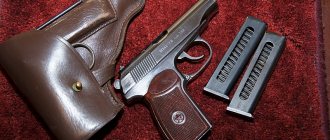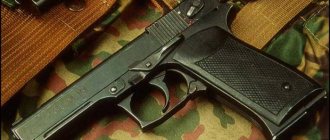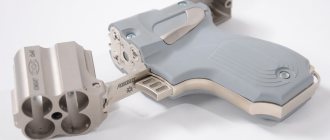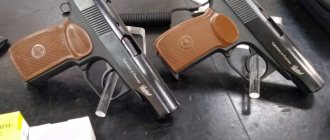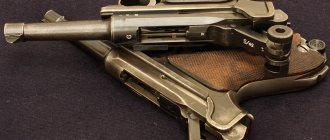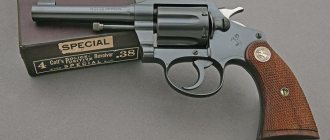This article is about the class of short-barreled firearms; for pistols with modern reloading principles, see: Self-loading pistol.
This term has other meanings, see Pistol (meanings).
The Makarov pistol
Pistol "Walter P99" disassembled
Flintlock pistols
Gun
(French pistolet ← French pistole from Czech píšťala - “pipe, pipe”) - a hand-held short-barreled small arms weapon designed to hit targets at a range of up to 25-50 meters. It can be either firearm or pneumatic. Early pistols were usually single-shot, with a smooth or rifled barrel. Modern pistols are mostly self-loading, rifled, with a significant magazine (from 5-7 to 15-20 or more rounds).
Story
Pistols of the 15th–19th centuries
Cavalry and ordinary wheeled pistols
The first pistols appeared in the 15th century. They were a short barrel mounted on a wooden block with a matchlock. Leonardo da Vinci invented a wheel lock for a pistol (started with a key) - this is his only invention that received recognition during his lifetime.
Pistols of that time were very different in design and purpose. Short pistols (puffers) were used for point-blank shooting. Long cavalry pistols had sufficient lethality at a range of up to 30-40 meters against an unprotected target. Heavy armor (like Maximilianovsky), however, they rarely penetrated even when fired at point-blank range, and the bullet speed rarely exceeded 150-160 m/s (for pocket “puffers” it could be less than 100 m/s).
In the 17th-18th centuries, the wheel lock was supplanted by the flintlock, which was less reliable in terms of misfires, but easier to load, cheaper and not afraid of dirt; in the first half of the 19th century, the latter was replaced by a capsule or piston lock.
Since the flintlock pistol was single-shot, various attempts were made to increase the pistol's rate of fire. This led to the appearance of double-barreled and even multi-barreled samples. Already in the 16th century, a revolver was invented (that is, a pistol with a drum - one of the first examples of Russian work from the beginning of the 17th century is kept in the Armory).
Six-shot revolver with wheel lock (~1590)
However, it did not become widespread because it was very expensive, difficult to manufacture and bulky, the powder gases in it often burst out, and at the same time it did not provide the main advantage of the later revolver - continuous shooting (due to the features of the flintlock, which required adding gunpowder after each shot on the shelf). Most often, single-shot pistols were made and carried in pairs, allowing at least two shots to be fired one after the other.
Later, for greater accuracy of the shot, rifling was made in the barrel of the pistol, which allowed the bullet to rotate in flight and hit the target accurately. This technology is prevalent today.
Dueling weapon
By the beginning of the 19th century, with the disappearance of the sword from everyday use, pistols became the main dueling weapon. The duel with flintlock pistols is described in detail in A. Pushkin’s novel “Eugene Onegin”:
Now the pistols are already flashing, the hammer rattles on the ramrod, bullets go into the faceted barrel, and the trigger clicks for the first time. Here the gunpowder is pouring onto the shelf in a bluish stream. Serrated, Securely screwed in flint Cocked yet...
Of the pistol makers of the Napoleonic era, Jean Le Page (Lepage) was especially famous, with whose pistols Pushkin’s heroes and Pushkin himself were shot, except for his last fatal duel. Pushkin shot with Dantes using pistols from the Dresden master Karl Ulrich, which belonged to the French envoy Barant. Three years later, Barant’s brother Ernest used the same pistols to shoot at Lermontov. Nowadays they are kept in the Postal Museum in Grenoble (France)). Ulrich's pistols, unlike Le Page's, were not flintlock, but more advanced - capsule.
In the 20th century, old-style single-shot pistols with a cap lock continued to be used in duels - in other areas of life they had long been supplanted by revolvers and automatic pistols.
Self-loading pistols
Pistol Vis.35 - automatic with a short barrel stroke
Bersa Thunder 380 pistol
Self-loading pistols automatically carry out the reloading process using the energy of powder gases. This distinguishes them from non-automatic pistols and revolvers, in which the reloading mechanisms are activated by the muscular strength of the shooter.
At the end of the 19th century, numerous attempts were made to create such a pistol. By the beginning of the 20th century, the Luger P08 and Mauser C96 models were developed [Note. 1]. In 1909, the Roth-Steyr M1907 self-loading pistol was adopted by the Austrian cavalry.[1] This was the first time a large military formation adopted a self-loading pistol.
In the period between the world wars, self-loading pistols gained dominance over revolvers, which were removed from standard weapons in the army and police of most countries and were pushed into the area of mainly self-defense weapons.
Currently, the vast majority of modern pistols are self-loading.
Abroad, self-loading pistols with a single-fire function are called semi-automatic
(English: Semi-automatic pistol).
Automatic pistols
Some self-loading pistols also have the ability to conduct fully automatic fire (Soviet APS, Austrian Glock-18) or fire in bursts of constant length (Italian Beretta 93R), but this ability is used quite rarely, since the low mass of the pistol leads to a large dispersion of bullets when firing, and in the case of an increase in mass and, often, size, the weapon moves into the class of submachine guns. One of the smallest automatic pistols was the Hummingbird pistol.
Abroad, pistols that have the ability to fire continuously are called machine guns
(eng. Machine pistol).
In Russian terminology - automatic
or
self-firing
.
Sporting target pistols
Sports pistol
A sports-target pistol is a pistol for sports shooting at a round target. They are single-shot and multi-shot, most often they use a small-caliber rimfire cartridge (5.6 mm), such as the MTs-55 or TOZ-35 pistols. They are distinguished by increased manufacturing precision, adjustable sights, a lighter trigger, devices for balancing, and “anatomical” handles made individually according to the shooter’s hand.
b ьХПННЛ ОНМХЛУМХХ ГМУВЭМХЪ, ОХЯРНИНЛ MYUGSHBUERYAЪ RN NTsMEYARPEKEMNE NPSFHE, YNRNPNE BN BPEL YARPEKEASH LNFMN SDEPFKHBURE NDMNI PSYNI. schRN NOPEDEKEMHE ME NRMNYAHRYYA Y BMEMELS BHDS X SYARPNIYARBS OPEDLERYU. schRNR BHD YARPEKINBNTSN NPSFKH KHLEER TKSANYSCH KHYARNPKHCH, MEYALNRP MU RN, VRN ONЪBKHKYA NM YAPYUBMHREKEMN MEDIUBMN. oEPBSHHE FE NAPYUGZHSH NTSMEYARPEKEMNTSN NPSFKH, TsDE HYAONKEGSERYA SCHMEPTsKH YATSNPUCHYETSN ONPNNUYU DK LERYUMH YAMYUPDNB, ONBKHKHYAE B MYUVYUKE XIV BEYU.
THRHKEMSHI OKHYARNKER
oPEFDE VELSCHRN NPSFHE YARYUKN LBHPNYN OPHLEMREYA, OPNKN MELYUKN BPELEMKH, MN, REL ME LEMEE, SCHRN KHGNAPEREMKHE ONKMNYARECH KHGLEMKHKN YAONYAN BEDEMH BNIM. b YAEPEDHME XVI BEYU ONEBKCHRYA “LUKEMEYKHE PSFE”, YNRNPSHE ONGBNKKKH YARPEKRE NDMNI PSYNI. TNPLYUKEMN KHGNAPERYUREKEL YAVKHRYUERYA KHRYUKEMYAYKHI NPSFEIMSHY LYUAREP yYULHKK BEREKKH (B DPSTSKHU HYARNVMKHYUU - yYULEKHN), MN RUYFE LNFMN OPEDONKNFHRE ONEBKEMKHE OKHYARNKERYU X B TsEPLYUMHH, BNGLNFMN, DUFE VSRE PUMEYE, VEL B xRYUKHH. rEPLHM "OHYARNKER", YUY OPKHMIRN YAVKHRYURE, OPNKHYAUNDHR NR MYUGBYUMKH TSNPNDYU oKHYARNI, TsDE FHK ETSN YANGDUREKE. MN RUYFE BNGLNFMSH KHMSHE BYUPHYUMRSH: KHAN NR HYAOYUMAYNI GNKNRNI LNMERSH, BREAD MYUGBYUMHE “OHYARNKE”; NR KHRYUKEMMYAYNTSN YAKNBYU "OHYARYUKKN" (pistallo), VRN NGMYUVYUKN TsNKNBYS OEPEDMEI KSYKH YAEDKYU, YSDYU LNFMN ASHKN ONDBEKHBURE OKHYARNKER DN ONEBKEMKH YAEDEKEMNI YNASPSH; KHAN NR VEYAYNTSN pistala - DSDU, BEDE YARBNK OKHYARNKERYU OPEDYARYUBKK YANANI FEKEGMSCH XKH APNMGNBSCH MEDKHMMSCH RPSAYS. oKHYARNKERSH ASHKKH KETSVE, VEL HYAONKEGNBUBHEYA RNTSDU PSFE, MN YARPEKAYU KH MHU ASHKYU ANKEE LERINI, OPYUBDU, OPH YNPNRYKHU PUYAYARNJMKHU. ONSCHRNLS KH OKHYARNKERNB NASHVMN YARPEKKKH YUBYUKEPHYARSH. oEPBNMYUVYUKEMN HYAONKEGNBYUKHYAE PEIRYUPYULH, SPNFEMZHYULH TsEPLYUMHH, YNRNPSHE, ONDYAYYUYUB Y BPYUTSS, PYUGPYUKH OKHYARNKERSH, YU GYUREL NRZEGFYUKH MU AEGNOYUMNE PYUYA RNЪMHE, VRNA KHU OEPEGYUPЪDHRE. ONEBKEMHE OKHYARNKERNB YARYUKN BNGLNFMSHL AKYUTSNDYUP YANGDYUMKHCH HYAYPNBSHU GYULINB: BMYUVYUKE YNKEYAZHNBSHU (YNKEYAZHNBSHI GYULNY - EDKHMYARBEMMNE HGNAPEREMHE KENMYUPDN DU BHMV X, ONKSVKHBEE OPHGMYUMHE OPH ETSN FHGMH), YU ONRNL X SDYUPMN-YPELMEBSHU. DN SCHRNTSN ASHKKH RNKEIN NRDEKEMSHE MEANKEKHE NAPYUGZHSH NTsMEYARPEKEMNTSN NPSFKH, KH NMH ME LNTSKKH ONKSVKHRE DNAFMNTsN PUGBHRKH, RYU YUY B MHU OPHLEMKYA THRKHKEMSHI I ONYANA BNYAOKULEMEMKH GYUPDYU. MN, MEYALNRP MU ANKEE BSHYANYSCH REUMKHVMNYARE, VEL OPEDSHDSYKHE THRKHKEMSHE GYULYKH, KHYAYPNBSHE RNKEIN NYAMNBYUKH OKHYARNKERSH YUY NRDEKEMSHI BHD, ME YAONYANAYARBS OPH SHCHR NL KHU PUGBHRHCH, ONRNLS VRN NAKYUDYUKH ANKEHL YNKHVEYARBNL MEDNYARYURYINB. ONVRKH DBYU I ONKNBKHMNI YARNKERKH B YABNEL SYARPNYARBE OKHYARNKERSH OPIURKHVEYAYKH ME LEMKKHYAE. gyu ShRN BPEL LNFMN NRLERKhRE RUYHE LNLEMRSH HU PUGBHRKH: Y YNMZHS XVI BEYU MYULERKHKNYAE SBEKHVEMHE DKHMSH YARBNKYU I MEINRNPSHL SLEMEMHEL YUKHAPIU; B REVEMKHE XVII BEYU BSHREYAMEMHE HYAYPNBSHU GYULYNB SDYUPMSHLH YPELMEBSHLH; ONЪBKEMKHE BN BMEMKHU TNPLYUU (NYANAEMMN B PSYNYRYYUU) ANKENNTSN HGYYYARBU. RUYFE B SHRN BPEL BNGMKHYUER MNBYU PYUGMNBKHDMNYARE —
DSSHKEMSHE OKHYARNKERSH
, NRKHVYUCHYHEYA NYANAN BSHYANYHLH YUVEYARBYULH. yNMEVMN, GYU BYAE ShRN BPEL OPEDOPKHMKHLUKHYAE ONOSHRYKH SYANBEPEMYARBNBYUMKH OKHYARNKERNB, MN, YUY OPYUBHKN, NMH ASHKKH LEMEE PEGSKERYURKHBMSHLH: MYUPЪDS I MEANKEHL X SKSVIEMKHLH BSHPHYANBSHBUKYA X PJD MEDNYARYURYINB, RYUHU, YUY TSPNLNGDYNYARE X YAKNFMNYARE SYARPNYARBU, YNRNPYU NYUGSHBUKYUYAE MEONYAHKEMNI DK OPHLHRKHBMN CN OPNKHGBNDYARBU RNCN BPELEMKH.
dSSCHKEMSHE OKHYARNKERSH
th MYUVYUKS XIX BEYU, I SUNDNL ІУЦХ ХГ ONБЯЭДМБМНЦН NAHUNDU, OKHYARNKERSH YARYUKH NYAMNBMSHL DSSHKEMSHL NPSFHEL. dSSCHKE MU YPELM╦BSHU OKHYARNKERYUU ONDPNAMN NOKHYYUMYU B PNLUME OSYKHMY “EBTSEMKHI NMETSKHM”:
bNR OKHYARNKERSH SF AKEYAMSKKH, tsPELHR N BNLONK LNKNRNY, b TsPUMEMSHI YARBNK SUNDER OSKKH, x YEKYMSK B OEPBSHI PYUG YSPNY. bNR ONPNU YARPSIYNI YAHMEBYURNI mu ONKYS YASHOKERYA. gSAVIURSHI, mYUDEFMN BBHMVEMMSHI YPELEME bGBEDEM EEE...
xG OKHYARNKERMSHU LYuYAREPNB MUONKENMNBYAYNI SHCHONUKH NYNAEMMN YAKYUBHKYA FYUM KE oYuF (kEOYUF), MU OKHYARNKERYU YNRNPNTsN YARPEKKKHYAE TSEPNH OSYKHMYU X YAYUL OSYKHM, YPNLE YABNEI ONYAKEDMEI PNYNBNI DSSHCHKH. I DYUMREYANL OSYKHM YARPEKKYAKHG OKHYARNKERNB DPEGDEMYAYNTSN LYUAREPIU yUPKYU SKEPKHYU, OPHMYUDKEFYUBKHU TPYUMZHSGYAINLS ONYAKYUMMMHYS AYUPYUMRS. xG SHCHRKHU FE OKHYARNKERNB APYUR DE AYUPYUMRY schPMEYAR VEPEG RPH TSNDU YARPEKKYA KEPLNMRNBSHL. mSHME NMH UPYUMRYA B lSGEE ONVR B TsPEMNAKE (tPYUMZHKH). oKHYARNKERSH sKEPKHUYU, B NRKHVKHE NR KEOYUFYU, ASHKKH ME YPELMEBSHE, YU ANKEE YANBEPEMMSHE - OKHYARNMMSHE.
yYUBYUKEPKHIYAYKHE OKHYARNKERSH
“YYuFDSHI YYUBYUKEPHYAR PSYAYAYNI YUPLHH BNNPSFYUKYA OYUPNI YAEDEKEMSHU OKHYARNKERNB, UPYUMKHBHYA B YNASPYUU, GYUPEOKEMMSHU HE NAEHL YARNPNMYUL KSYKH YAEDKYU. yPNLE YYUBYUKEPHYARNB, RYYHLH FE OKHYARNKERYULH BNNPSFYUKHYAE YNMMSHE YUPRHKKEPHYARSH, OKHNMEPSH OUNRSH H NTHZHEPSH BYAU PNDNB BNIYAY.” YaOEYRP OKHYARNKERNB ASHK DNBNKEMN KBNY, RYU YU LMNTskhe NTKHZHEPSH ONYSOYUKH YAAE SCHRN NPSFHE GYU YABNI YAVER, KH VUYARN KHLEKH DNPNTSKHE KHMNYARPYUMMSHE NAPYUGZHSH PUANRSH BEDSYKHU PSF IMHYNB LHPYU. with PJDNBSHU FE YYUBYUKEPHYARNB YYULSHL PUYAOPNYARPYUMEMMSHL ASHK 7-KKHMEIMSHY (17.8-LL) YYUBYUKEPHIYAYKHI YANKDURYAYKHI OKHYARNKER NAPYUGZHYU 1809 TSNDYU. b LEMEYEL YNKKHVEYARBE B BNIYAYU ONYARYUBKKKYA SYANBEPEMYARBNBUMMSHY BYUPKHYUMR SHRNTSN NPSFKH I SYNPNVEMSHL (DK NAKETSVEMKHЪ) ZHEBEEL H NLONKNL, OPHYPEOKEMMSHL ONDB HFMSHL YNPNLSHYAKNL Y YARBNKS (BN HGAEFYUMKHE SREPH). schRN NPSFHE YAVKHRYUKNYAE NTKHZHEPIAYHL X BSHDUBUYUKNYAE REL LKYUDKHL YNLYUMDHPYUL, YNRNPSHE ME HLEKH YAPEDYARB DK ONYSOIKH YANAYARBEMMNTSN NPSFKH. bNNPSFYUKHYAE OKHYARNKERYULH GYU YABNI YAVER KHPPETSKЪPMSHE VYUYARKH - YUGYUYKH. nMH BKYUDEKH YAYULSHLH PUGMNNAPYUGMSHLH NAPYUGZHYULH, NDMYYN VYUYE YUGYUVEH "YARBNKSH" HLEKH OPHGMYUYH BNYARNVMNTSN NPSFKH: YAOSYAY B TNPLE ME YPCHVYU, YU YUPKHYU, NRYASRYARB HE GYUYHRMNI YAYNASH YAOSYAYU, ANTSYURSHI NPMYULEMR B BNYARNVMNL YARHKE. eYAKKH PYUZHNMYUKEMNYARE BNNPSFEMKH RFEFKNI YNMMKHZHSH PSFEEL HKKH LSYERNMNL BSHGSHBYUKYU MELYUKN YANLMEMKHI (KH-GYU KHGKHMETSN SRFEKEMKH TPYUMZHSGYAYNTSN YUBYUKEPKH YARYU LMNTsNVHYAKEMMSHL X PUGMNNAPYUGMSHL NPSFHEL), RN MENAUNDHLNYARE MYUKHVKH OKHYARNKERNB, ASDE RN S YHPYYAHPYU, TSSYAYUPYU HKH SKYUMYU, ASHKYU NVEBKHDMNI. BYAE TPYUMZHSGYAYHE YYUBYUKEPHYARSH SHCHONUKH oEPBNI HLOEPHH KHLEKH B NAIGYUREKEMNL ONP'DYE NDHM-DBYU OKHYARNKERYU B YAEDEKEMSHU YNASPYUU (YUY OPYUBHKN, NDHM - HG-GYU MEUBURYKH SCHRNTSN BKhDU NPSFKH; OYUPNI OKHYARNKERNB YALNTSKKH ONTsNKNBMN BNNPSFKHRE RNKEIN YANKDYUR YHPYYAKHPYAYKHU X YYUPYUAHMEPMSHU ONKYNB). b ANKEHMYARBE YABNEL SHRN ASHKKH OKHYARNKERSH LNDEKH IX X XIII, MN BYARPEVIUKHYAE KH ANKEE PUMMKHE NAPUGZHSH, B VYUYARMNYARKH LNDEKE 1763 C., Y MEINRNPSHE KH YYUBYUKEPHYARNB KHLEKH MY BNNP SFEMXX DUFE OKHYARNKERSH, KHTsNRNBKEMMSHE B OEPBNI ONKNBKHME XVIII B. vYuYARN TPYUMZHSGYAIKHLH YUBYUKEPKHYARYULH HYAONKEGNBUKHYAE H RPNTEIMSHE SHYGELOKPSH. oPHZHEKEMYU DUKEMNYARE YARPEKEASH HG OKHYARNKERYU RNCN BPELEMKH ASHKYU RYUNI, VRN OPIYRKHYKH BNEMMNTSN DEKYu PAINLEMDNBYUKH YARPEKYRE HG METSN... B SONP! “dK SCHRNTSN ME MUDN RYYUREKEMN ZHEKHREYA”, - PAINLEMDNBYUKH YAOEZHYUKHYARSH. - MN MEKEG, VRNASH YNMEZH YARBNKYU YYUAYUKYA REKYU BPIUTSYU, ONRNLS VRN OKHYARNKER B SHCHRNL YAKSVUE LNFER PUGNPBUREYA KH PUMHRE YYULNTSN YARPEKCHYETSN.” MER, YNMEVMN, YARPEKKKH X I DEYARKH, X I DBYUJURKH ANKEE YUTSNB, NDMUYN RNVMNYARE OPH SCHRNL ASHKYU MEBEKKHYU. RYUY, OPH YARPEKEAE I YNM MU PSHYAH KSVIKHE YARPEKYKH OPNLYUKHBYUKKHYAE OPHLEPMN B 50% YAKSVUEB, YU MU TSYUKNOE - B 75%! yu ONOYUDYUMKHE B ZHEKE YAN YAOKHMSH YARNYYEI KNYUDH MU DHYARYUMZHHH B 30 YUTsNB YAVHRYUKNYAE VHYARNI BNDSH YAKSVIUMNYARECH... yYUBYUKEPHIYAYKHI OKHYARNKER 1763/1766, (YUKHAP 17.1- LL, BEYA 1.23 YTS) YANGDIUMMSHI EY OPH YNPNKE kCHDNBHYE XV, OPEDMYUGMYUVYUKYA B OEPBSCH NVEPEDE DK DPYUTSSM. bSHOSYAYUKYA B DBSU BEPIAHU: 1-Ъ LNDEKE (1763) NYUGYUKYUYAE YAKKHYNL TSPNLNGDYNI (DKKHMYU 48 YAL), ONSHRNLS ONBKHKYUYAE 2-Ъ, SINPNVEMMYU LNDEKE (1766) DKHMNI 40.2 YL. nPSFHE BSHOSYAYUKNYAE DN 1777 TSNDYU, B NAYEI YAKNFMNYARKH ASHKN KhGTSNRNBKEMN 28000 OYUP (56000 BP). th MYUVYUKS MUONKENMNBYAYKHU BNIM ShchRKH OKHYARNKERSH SFE YAVKHRYUKKHYAE SYARYUPEBHLH, NDMUYN HG-GYU MEUBURYKH NPSFKH YUYRKHBMN OPHLEMKKHYAE B ANEBSHU DEYARBKHYU (YNMEVMN, B MEYAINKEIN NTsPYUMHVEMMSHU LYUAYUAYUU - GMYUVHREKEMYU VYUARE HG BSHOSYEMMSHU B XVIII BEYE NAPYUGZHNB SFE ASHKYU SRPYUVEMU B ONYARNMMSHU BNIMYUU). MEANKENNI ON PUGLEPYUL TPYUMZHSGYAYKHI "YYURSKNVMSHY" OKHYARNKER NAPUGZHYU 1777 C YUKHAPIU 17.1-LL, REL ME LEMEE, ASHK DNBNKEMN RFEFKSHL (BEYA - 1.4 YTs). MYUGBYUMKHE "YURSKNVMSHI" ASHKN YABGYUMN I MENASHVMNI YNMYARPSYZHHEI OKHYARNKERYU: BEYAE LEYUUMKHGL NPSFKH ASHK PYUGLEYEM B LEDMNI YNPNAYE (“YURSKYE”), B YNRNPSCH BBKHMVKHBUK YYUGEMMSHY YAPEG YARBNKYU. RYUYUYU MEYARYUMDYUPRMYU YAUELYU ASHKYU OPKHMRYU ON MUYARNMHCH TSEMEPYUKYU DE TsPHANBUK, RYUKYUMRKHBNTSN YUPRHKKEPKHYARYU, YNRNPSHI OPEDONVKHRYUK YAKHYARELSH, UYUPYUYREPMSHE DKЪ ETSN PNDYU BNIYAY. "YURSKNVMSHE" OKHYARNKERSH OPNKHGBNDHKHYAE RNKEIN DN BEKKHYNI TPYUMZHSGYAYNI PEBNKCHZHKH, NDMUYN OPHLEMKKHYAE B BNIYAYUU DN YYULNTSN YNMZHYU MUONKENMBYAYNI SCHONOEKH. "YURSKNVMSHY" OKHYaRNKER AN-IX NAPYUGZHYU 1801 Ts ASHK PYUGPYUANRYUM DK BNNPSFEMKH YANKDYUR YYUBYUKEPKHH; NM BSHDUBUKYA YKHPYYAHPYUL, DPYUTSSMYUL, TSSYAYUPYUL, SKYUMYUL H YNMMSHL ETSEPIL. oPHVEL OYUPNI OKHYARNKERNB BNNPSFYUKHYAE RNKEIN YHPYUYAKHPSH KH YYUPYUAHMEPSH, NYARYUKEMSHE YYUBYUKEPHYARSH ONKSVYUKH RNKEIN ON NDMNLS OKHYANKERS (SCHRN ASHKN YABYUMN I MEUBYURYNI NPSFKH B YUPLXX MNBNTsN, LYuYAYANBNTSN RHOYU, Y NYAMYUYEMHCH YNRNPNI TPYUMZHSGYAYU OPNLSHKEMMNNYARE NYUGYUKYUYAE ME TsNRNBYu). oKHYaRNKER B SHHRNI BEPAKHH BSHOSYAYUKYA BYAETSN 4 TsNDYu; EYE 3 TsNDYu OPNKHGBNDHKYYAE ETS MEYAYNKEIN HGLEMEMMYU BEPYAKH "lNDEKE AN-XII" (HGLEMEMKH YNYAMSKHYAE RNKEIN YAONYANAYU YPEOKEMKH YARBNKYU KNFS). ndMUYN GYU SHRN BPEL ASHKN BSHOSYEMN NYNKN 80 RSHYA. RUYHU "YARBNKNB". tPYUMZHSGYAYKHI OHYARNKER AN-IX (AN-XII) NAPYUGZHYU 1805 Ts ASHK YYULSHL YANBEPEEMMSHL X PUYAOPNYARPUMEMMSHL OKHYARNKERNL TPYUMZHSGYAYNI YYUBYUKEPHH (BSHOSYEMN NYNKN 300 RSHYA. SCHYGELOK PNB). nM ьХПНН ОПХЛМЪКЯЪ B BNYAYUU - B NYAMNBMNL YUY NANPNMHREKEMNE NPSFHE, RYU YUY B MUYARSOKEMXX TPYUMZHSGYAYU YYUBYUKEPKH ANKEE BYAETSN ONKYUTSYUKYUYAE MU UNKNDMNE NPSF HE - YAYUACCH XKH OYUKYU.
nTHZHEPIAYHE X YANKDURYAYHE OKHYARNKERSH
bN TPYUMZHSGYAYNI YUPLHH DEYARBNBUKN OPYUBHKN, ON YNRNPNLS NTHZHEPSH ME ONKSVYUKH NPSFHE NR OPYUBHREKEYARBU, YU GYYSOYUKH ETSN GYU YABNI YAVER. schRN OPKHBNDHKN Y NTSPNLMNLS PYUGMNNAPYUGKHCH LNDEKEY B BNIYAYUU, RYU YUY UNR VYUARE NTKHZHEPNB (B NYAMNBMNL AEDMSHE) ONYSOYUKYU SYARYUMNBKEMMSHE PETSKYULEMRNL MEDNPNTSKHE Y PLEIYAYHE NAPYUGZHSH, ANKEHMYARBN YARYUPKHU YNLYUMDHPNB OPEDONVKHRYUKH GUYYUGSHBURE WITH GMYULEMHRSHU NPSFEIMKHYNB SCHYAYKCHGKHBMSHE, PNYAYNMSHE X DNPNTSKHE OKHYARNKERMSHE OYUPSH, YAX FHBHE OPEDLERNL TSNPDNYARH BKYUDEKEJU. REL ME LEMEE, BYAE NTHZHEPIAYHE OKHYARNKERSH (X YARYUMDYUPRMSHE, X GYUYUGMSHE) NRKKHVYUKYU NAYU NYANAYEMNYARE, SYUGSHBUCHYU MU HU OPKHMYUDKEFMNYARE YNLYUMDHPS. eYAKKH YANKDYURYAYKHE NAPYUGZHSH NAYGYUREKEMN HLEKH MU PSYNRKH LERYUKKKHVEYAYSCH OERKCH HKKH YAYNAS DK YPEOKEMKH PELM, NTHZHEPYAYKHE SHYGELOKPSH RPYUDKHZHNMMN KHCTSNRYUBKH BYUKKHYAE AEG SCHRNI OERKKH, I TSKYUDYHL YPSTSKSHL "JAKNYNL".
oKHYARNKERSH OEPBNI ONKNBKHMSH XIX BEYU.
oEPKHND DN MYUVYUKYU XIX BEYU LNFMN YAVKHRYURE OPEDSHYARNPKHEI OKHYARNKERNB. b SCHRN BPEL YABYYEMMMHY(!) HG bNRKYUMDKHH yukeyYuMDP dFNM tNPYAHR HGNAPERUER SDYUPMN-YUOYACHKEMSHI GYULNY, GYUOYUREMRNBYUB B 1807 TsNDS SDYUPMSHI YANYARYUB DK BNYAOKYULEM EMKH GYUPDYU. x BNR, MUYNMEZH, AKYUTSNDYUP MNBNBBEDEMKHCH DK BYAETSN NTsMEYARPEKEMNTSN NPSFKH, X DK OKHYARNKERNB B VYUYARMNYARKH, MUYARSOYUER ONPU PUGBHRKH X YANBEPEMYARBNBUMH. sFE B MYUVYUKE 40-U TsNDNB XIX BEYU RUYNE NPSFHE YARYUBHRYAJ MU BNNPSFEMHE YUPLKHI. yPNLE YUOYACHKEY YAN BGPSHBVURSHL BEYYARBNL, MU SIAOU ONBKKHKN ONBKEMKHE BPYUYUCHYUTSNYA AYUPYUAYUMYU, MYUPEGMNI YARBNK H GUDMЪ YULNPYU, YNRNPYU BYARYUBKK YUYAE I YUGEMMNI VYYARH. YNMYARPSYRNPSH B OEPBSCH NVEPEDE DEKYUKH YARYUBYS MU ONBSHYEMKHE YAYNPNYARPEKEMNYARKH OKHYARNKERNB, ONYAINKEYS LERYNYARE KH DUKEMNYARE BSHYARPEKYU, SANIMYU YAHKYU OSKH X YNLOYUYRMNYAR E B YUYNI-RN YAREOEMKH ASHKKH SFE NAEYAOEVEMSH. yu BNR YAYNPNYARPEKEMNYARKH OPYURKHVEYAYKH ME YASYYYARBNBUKN. dKHREKEMNYARE OPNZHEYAYU GYUPFYUMH I DSKYU, OPH SYAKNBHH AKHGNYARH OPNRHBMKHYU, ON YSRH, OPEDSYALYURPHBUKYU, VRN SCHRN ASDER NPSFHE PUGNBNTSN DEIYARBKH. b 1836 Ts.
PEBNKEBEP
SPNFEMZHYU IYULSSCHK YNKERYU. nM ONKSVIUER MYUGBYUMKHE "oYUREPYANM" ON KHLEMKH TSNPNDYU, B YNRNPNL ASHK BSHOSYEM. YNKER ME ASHK YNMYARPSYRNPNNL SHRNTSN NPSFHЪ, YU ЪБКЪКЯЪ BYAETSN KHIE RYUKYUMRKHBSHL AKHGMEYALEMNL X OPNLSHKEMMHYNL. MUYARNYKHI YANGDUREKE PEBNKEBEPYU (RNFE YLEPHYUMEZH) - dFNM oKhPYANM... mN SCHRN SFE YANBYAEL DPSTSYU KHYARNPKH.
lYUREPHYUKSH MYUDSHAYUK, MYUDEPTSYUK HG YAERKH KH ONDTSNRNBKHK Y OEVYURKH TSKYUBPED yu. PSYNUBNYAR
Type 26
This weapon is also known as the Hino revolver. It was developed in Japan in 1893 and was also adopted by the Imperial Japanese Army. This model got its name due to the special chronology that is still used in its homeland.
Initially, it was decided to adopt this revolver for cavalry use. In this case, a safety cord was used, attached to a ring on the handle. It is a breakaway style pistol and was somewhat similar to the early Smith & Wesson models. The trigger worked without a spoke. The weapon used 9×22 mm R cartridges.


